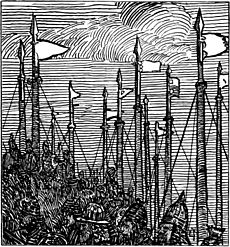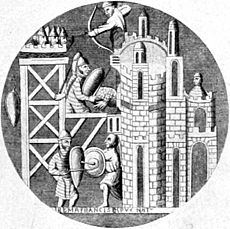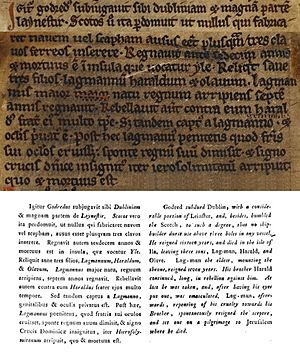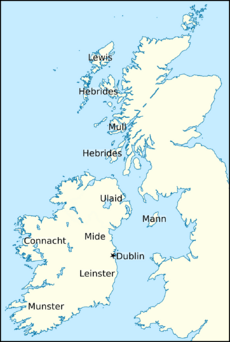Lǫgmaðr Guðrøðarson facts for kids
Quick facts for kids Lǫgmaðr Guðrøðarson |
|
|---|---|
| King of the Isles | |

Lǫgmaðr's name as it appears on folio 33v of British Library Cotton Julius A VII (the Chronicle of Mann): "Lagmannus".
|
|
| Reign | 1103–1110 |
| Predecessor | Sigurd Magnusson |
| Successor | Domnall mac Taidc Uí Briain |
| Born | 11th century AD |
| Dynasty | Crovan dynasty |
| Father | Godred Crovan |
| Religion | Catholicism |
Lǫgmaðr Guðrøðarson was a king who ruled the Kingdom of the Isles in the late 1000s and early 1100s. He is also known as Lagmadr or Lagman of the Isle of Man. We don't know much about how he became king, what his rule was like, or how he lost power.
Lǫgmaðr was the oldest son of Guðrøðr Crovan. His father was a Norse-Gaelic ruler who took control of the Isles and Dublin. Guðrøðr died in 1095. Three years later, Magnús Óláfsson, the King of Norway, conquered the Isles. He ruled there until he died in 1103. It's not clear exactly when Lǫgmaðr became king. It might have been before Magnús arrived, during his rule, or after Magnús died.
As King of the Isles, Lǫgmaðr faced many challenges. His younger brothers, Haraldr and Óláfr, had supporters who opposed him. At one point, people from the Isles asked Muirchertach Ua Briain, the King of Munster in Ireland, to choose a temporary ruler for them. This might have been done by those who supported Óláfr. Ua Briain sent a relative from his own family to rule. But the people of the Isles didn't like this new ruler. They soon forced him out, possibly led by Lǫgmaðr's own supporters.
The end of Lǫgmaðr's reign is also a bit of a mystery. One old story says he gave up his kingship willingly. It says he then traveled to Jerusalem and died there. This could mean he went on a crusade. Perhaps he joined the First Crusade or the Norwegian Crusade. Another idea is that he was forced to leave his kingdom. The story says he felt bad for being cruel to his brother Haraldr. But it's also possible he was simply forced out of power. After about ten years, Lǫgmaðr's youngest brother, Óláfr, became king. This brought the Crovan dynasty back to power.
Contents
Lǫgmaðr's Family and Early Rule
Lǫgmaðr was one of three sons of Guðrøðr Crovan. Guðrøðr became important in the mid-1000s. We don't know exactly who his parents were. But he seemed to be a descendant of Óláfr kváran. This family connection gave him a claim to rule the Norse-Gaelic kingdoms of Dublin and the Isles. In the 1070s, Guðrøðr conquered the Isle of Man. This made him King of the Isles. He also took control of Dublin in 1091. Guðrøðr lost power in 1094 when he was driven out of Ireland. He died the next year in the Hebrides.
The situation in the Isles in the late 1000s is not very clear. We know that Magnús Óláfsson, the King of Norway, sailed into the Isles. He took control of the kingdom. He stayed in power in the Irish Sea area until he died in 1103. The Chronicle of Mann says that when Guðrøðr died in 1095, Lǫgmaðr became king. It says he ruled for seven years. But the dates and numbers in this old book are not always exact. So, we don't know if Lǫgmaðr started ruling before Magnús arrived, during Magnús's rule, or after Magnús died. One idea is that Lǫgmaðr became king of the Isles right after his father took control of Dublin in 1091. This would show how important Dublin was to the Norse-Gaelic rulers.
Even though we don't know exactly when he started, the chronicle says Lǫgmaðr faced problems from his own family. His brother, Haraldr, rebelled against him. Lǫgmaðr eventually defeated Haraldr and punished him severely. The chronicle then says Lǫgmaðr felt bad for his cruelty. It says he gave up his kingdom and went to Jerusalem, where he died.
Irish Rulers Get Involved
The Chronicle of Man says Lǫgmaðr left his throne on his own. But it's possible he was forced out. Around 1096, the chronicle says the leaders of the Isles asked Muirchertach Ua Briain, the King of Munster, for help. They asked him to send a relative to rule the kingdom. They wanted this person to rule until Lǫgmaðr's younger brother, Óláfr, was old enough to be king. This story might mean that Lǫgmaðr was facing a group of people who supported his younger brother. When they couldn't defeat Lǫgmaðr on their own, they asked Ua Briain for help to put Óláfr on the throne.
Ua Briain was a very powerful ally. He had recently taken control of several kingdoms in Ireland, including Dublin. He had also driven Lǫgmaðr's father out of Ireland for good. This gave Ua Briain control of Dublin's strong navy. So, when the chronicle says Ua Briain was asked to provide a ruler from his family, it might have been his condition for helping, not just a request from the Islesmen. Ua Briain then put Domnall mac Taidc on the throne. Domnall was Ua Briain's nephew. He also had family ties to the Isles.
Domnall's rule was not popular. The chronicle says he ruled harshly for three years. Then, the leaders of the Isles revolted against him. They drove him out of the kingdom and back to Ireland.
Norway Takes Over
We don't know how much power Domnall really had. It's unclear if he controlled the northern parts of the Hebrides, which were far from the Isle of Man. Around 1097, King Magnús of Norway sent a man named Ingimundr to the Isles. Ingimundr was supposed to take control of the kingdom. He settled in the Isle of Lewis. But he was killed when he tried to take the kingship for himself. Ingimundr might have chosen Lewis because he couldn't get control of the Isle of Man itself.
The chronicle says that a civil war broke out on the Isle of Man the next year. An old writer named Orderic Vitalis said that Mann was so badly damaged it was almost empty when Magnús arrived. This war might have been related to the fights between Guðrøðr's sons. It's possible that Magnús forced Domnall out of the Isles. But the chronicle doesn't mention Domnall during the conflict on Mann. This might mean he had already lost control of the island. Soon after, Magnús himself arrived. This suggests that Ingimundr's death made Magnús decide to take matters into his own hands.
Old Norse stories describe Magnús's takeover of the Isles. These include Morkinskinna, Fagrskinna, Orkneyinga saga, and Heimskringla. As the Norwegian fleet sailed into the Isles, one story says Lǫgmaðr tried to defend the "Northern Islands." This likely means the Outer Hebrides. An old poem calls Lǫgmaðr "Prince of Uist." This suggests he had power in the northern Isles. It might also mean he was based on the island of Uist.
Sometimes, the Kingdom of the Isles was split between different groups. We don't know if Lǫgmaðr's presence in the north means the kingdom was divided then. Several sources say that the Norwegians took over the Isles and captured Lǫgmaðr. For example, Orkneyinga saga mentions this. Morkinskinna adds that Lǫgmaðr fled south by sea as Magnús's fleet advanced. But he was captured and stayed with the Norwegian king for some time.

Magnús stayed in the Isles for the winter. He then went back to Norway. He returned almost four years later, in 1102 or 1103. Once he was back on Mann, Magnús made a deal with Ua Briain. They sealed this alliance with a marriage. Magnús's young son, Sigurðr, married Ua Briain's daughter, Bjaðmunjo. Magnús probably planned for Sigurðr to rule his new lands. But Magnús was killed in Ulster in 1103. Sigurðr immediately left his new wife and went back to Norway. Ua Briain was able to get control of Dublin again. He still had a lot of influence in the Isles. But Magnús's death left a power gap that Ua Briain couldn't fill.
In 1111, Domnall mac Taidc seems to have taken the kingship of the Isles by force. He might have had Ua Briain's support, but some evidence suggests he acted on his own. Not long after this, Domnall was either forced out of the Isles or went back to Ireland. He might have wanted to take advantage of Ua Briain's poor health. But Domnall himself was killed in 1115. Other Irish groups trying to gain power in the Isles might have worried the English and Scots. The chronicle says that Óláfr, Lǫgmaðr's youngest brother, ruled for forty years after this. So, Óláfr likely became king around 1112 or 1113. The chronicle says Óláfr grew up at the court of Henry I, King of England. It seems that the English king helped bring the Crovan family back to power.
His Last Journey

In late 1095, Pope Urban II called for an armed pilgrimage, or holy war. This led to the First Crusade (1096–1102). Thousands of people answered his call to take back Jerusalem for Christians. The Chronicle of Mann says Lǫgmaðr left his kingdom "marked with the sign of the Lord's cross." This suggests he joined a crusade. However, the chronicle was written much later. So, this description might have been influenced by ideas about crusaders that were common at that time.
People joined crusades for many reasons. One reason was to show they were sorry for their sins. Lǫgmaðr might have joined because he felt bad about how he treated his brother. Another idea is that he didn't join a crusade, but just went on a pilgrimage to Jerusalem to ask for forgiveness. Joining a crusade could also be a way to escape political problems at home. This was true for Robert II, Duke of Normandy. For Lǫgmaðr, joining a crusade might have been a result of Magnús conquering the Isles in 1098. Or it could be because Ua Briain's family was trying to take over Dublin and the Isles again.
If Lǫgmaðr was a crusader, we don't know which crusade he joined. One possibility is the First Crusade. This crusade ended with the successful capture of Jerusalem in 1099. Lǫgmaðr might have started this journey around 1096. He could have joined Robert II's forces that summer. Or, since Lǫgmaðr was captured by the Norwegians in 1098, he might have been set free only if he agreed to go on the First Crusade. It's also possible he started a pilgrimage and then decided to join the crusade along the way. If Lǫgmaðr did join and die in the First Crusade, he might have died in Syria or Anatolia.
Another idea is that Lǫgmaðr regained some power in the Isles after Magnús died. Then, he might have joined Sigurðr's trip to the Holy Land in the early 1100s. We don't know if Sigurðr's journey was a planned crusade or just an exciting and violent pilgrimage. The exact dates of this trip are also unclear. But the Norwegian fleet definitely reached England before 1110. Lǫgmaðr might have joined Sigurðr when Sigurðr spent the winter at the English king's court. If Lǫgmaðr and Sigurðr met in England, this might have been when Óláfr, who would become the next King of the Isles, was left with the English king for safekeeping.



